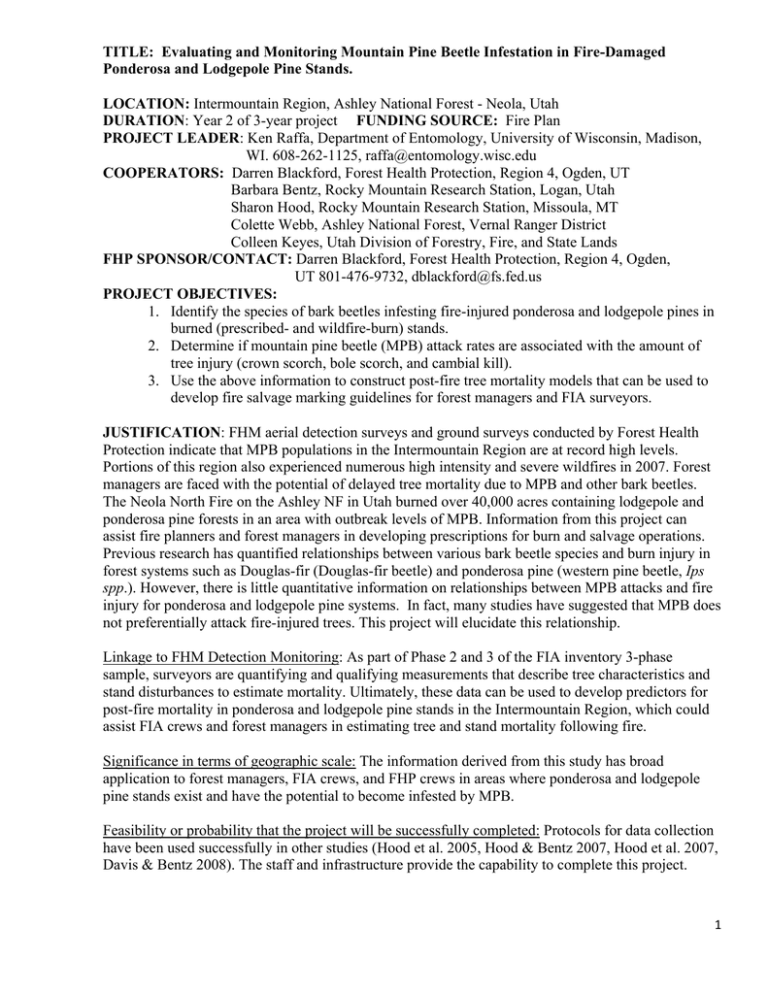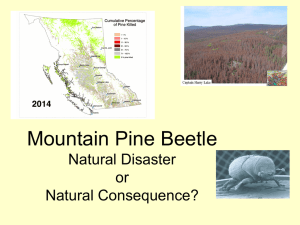TITLE: Ponderosa and Lodgepole Pine Stands. LOCATION: DURATION
advertisement

TITLE: Evaluating and Monitoring Mountain Pine Beetle Infestation in Fire-Damaged Ponderosa and Lodgepole Pine Stands. LOCATION: Intermountain Region, Ashley National Forest - Neola, Utah DURATION: Year 2 of 3-year project FUNDING SOURCE: Fire Plan PROJECT LEADER: Ken Raffa, Department of Entomology, University of Wisconsin, Madison, WI. 608-262-1125, raffa@entomology.wisc.edu COOPERATORS: Darren Blackford, Forest Health Protection, Region 4, Ogden, UT Barbara Bentz, Rocky Mountain Research Station, Logan, Utah Sharon Hood, Rocky Mountain Research Station, Missoula, MT Colette Webb, Ashley National Forest, Vernal Ranger District Colleen Keyes, Utah Division of Forestry, Fire, and State Lands FHP SPONSOR/CONTACT: Darren Blackford, Forest Health Protection, Region 4, Ogden, UT 801-476-9732, dblackford@fs.fed.us PROJECT OBJECTIVES: 1. Identify the species of bark beetles infesting fire-injured ponderosa and lodgepole pines in burned (prescribed- and wildfire-burn) stands. 2. Determine if mountain pine beetle (MPB) attack rates are associated with the amount of tree injury (crown scorch, bole scorch, and cambial kill). 3. Use the above information to construct post-fire tree mortality models that can be used to develop fire salvage marking guidelines for forest managers and FIA surveyors. JUSTIFICATION: FHM aerial detection surveys and ground surveys conducted by Forest Health Protection indicate that MPB populations in the Intermountain Region are at record high levels. Portions of this region also experienced numerous high intensity and severe wildfires in 2007. Forest managers are faced with the potential of delayed tree mortality due to MPB and other bark beetles. The Neola North Fire on the Ashley NF in Utah burned over 40,000 acres containing lodgepole and ponderosa pine forests in an area with outbreak levels of MPB. Information from this project can assist fire planners and forest managers in developing prescriptions for burn and salvage operations. Previous research has quantified relationships between various bark beetle species and burn injury in forest systems such as Douglas-fir (Douglas-fir beetle) and ponderosa pine (western pine beetle, Ips spp.). However, there is little quantitative information on relationships between MPB attacks and fire injury for ponderosa and lodgepole pine systems. In fact, many studies have suggested that MPB does not preferentially attack fire-injured trees. This project will elucidate this relationship. Linkage to FHM Detection Monitoring: As part of Phase 2 and 3 of the FIA inventory 3-phase sample, surveyors are quantifying and qualifying measurements that describe tree characteristics and stand disturbances to estimate mortality. Ultimately, these data can be used to develop predictors for post-fire mortality in ponderosa and lodgepole pine stands in the Intermountain Region, which could assist FIA crews and forest managers in estimating tree and stand mortality following fire. Significance in terms of geographic scale: The information derived from this study has broad application to forest managers, FIA crews, and FHP crews in areas where ponderosa and lodgepole pine stands exist and have the potential to become infested by MPB. Feasibility or probability that the project will be successfully completed: Protocols for data collection have been used successfully in other studies (Hood et al. 2005, Hood & Bentz 2007, Hood et al. 2007, Davis & Bentz 2008). The staff and infrastructure provide the capability to complete this project. 1 DESCRIPTION: a. Background: Forest fires occur commonly in pine forests of the western United States. Fire injury may affect a tree’s physiological processes (Ryan 2000), making them more susceptible to bark beetle attacks (Hood and Bentz 2007). There is some evidence to support mountain pine beetle attacks on fire-injured trees, although not at significant levels (McHugh et al. 2003), and others have suggested that this beetle is not attracted to trees in burned areas (Rasmussen et al. 1996). There are currently outbreak populations in Utah. The Neola North Fire of 2007 on the Ashley NF burned 40,000+ acres of pinyon, aspen, lodgepole, ponderosa, and Douglas-fir. Our initial ground surveys showed MPB attacks on partially scorched lodgepole and ponderosa pines. b. Products: Post-fire mortality prediction models for lodgepole and ponderosa pines. Quantitative information describing the relationship between fire-caused tree injuries and MPB attack and brood production. c. Schedule of Activities: Year 1: Set up permanent plots inside, at the fringe, and outside a wildfire area (Neola North Fire) in both ponderosa and lodgepole pine stands. Collect data on bark beetle attacks and brood production as they relate to tree fire injury classification. Year 2: Conduct data analysis using data collected in Year 1. Revisit all permanent plots, monitoring tree mortality, bark beetle attacks and MPB brood production. Year 3: Conduct data analysis. Revisit all plots and monitor tree mortality and bark beetle attacks. Develop post-fire tree mortality and MPB attack models. Complete final analysis and report. PROGRESS / ACCOMPLISHMENTS Year 1: Neola North Fire boundary delineations and vegetation maps were obtained from the Ashley NF and used to identify sites within burned ponderosa and lodgepole pine stands. Prior to beetle flight in May 2008, four sites were established in each tree species. At each site, 16 fixed radius plots (size varied with tree density) were systematically assigned (64 plots/ species; 128 total plots). Individual trees within plots were assessed for fire injury according to the methods of Hood & Bentz (2007), and assessed for bark beetle presence (Lodgepole: 1173; Ponderosa: 569). Four passive traps were hung within each site to estimate background bark beetle pressure. Five trees each of varying degrees of scorch and bole char were caged on their northern and southern aspects to determine MPB success. A preliminary summary is shown below. For simplicity, this table shows the relationships of just two beetle species with burned and unburned trees. The following beetles were observed infesting ponderosa and/or lodgepole pine: Dendroctonus ponderosae, D. valens, D. murrayanae, Ips spp., and Pityogenes spp. Members of Cerambycidae and Buprestidae were also found, but are not included. Overall, charred trees appeared more likely to be attacked than non-charred trees. However, it should be noted that few ponderosa pines had no bole char. The caging studies showed that charred trees can be suitable hosts for MPB. Brood production occurred in some charred trees of both species. However, in severely charred trees, it appeared that MPB is more successful in ponderosa than lodgepole pine. Year 2: All trees within plots established in year 1 were revisited and status (live, dead, beetleattacked) was determined. Attack location, within the burned or unburned portion of the bole, was noted for all trees with bark beetle attack. Passive traps were hung as in year 1 to monitor background population levels for comparison between years. Thirty attacked trees per species, of varying degrees of scorch, were caged on the north and south bole aspect to quantify beetle reproductive success in fire-injured trees. Each site had at least 5 cage trees, the remaining 10 trees were selected from any 2 site, to ensure a full range of scorch was sampled. The bark was peeled from 2008 cage trees and galleries of mountain pine beetle and any secondary bark beetles were counted to determine attack to brood ratios for each tree. Table 1 Percent of trees with bark beetle attack from mountain pine beetle and Ips by tree species Attack Year 2007 2008 2009* Total# FireInjury Burned Unburned Burned Unburned Burned Unburned Burned Unburned Ponderosa Pine n= 569 MPB Lodgepole Pine n= 1173 Ips 43 0 14 0 3 0 52 0 MPB 7 0 <1 0 <1 0 7 0 16 <1 15 9 5 3 31 10 Ips 24 <1 8 1 4 1 34 3 * May not be complete, as bark beetles were active at the end of the 2009 field season # Total is not equal to the sum of each year because some trees were attacked in more than one year All species found attacking trees in 2008 remain active within the burn areas. MPB has attacked 52% of all ponderosa pines and 41% of all lodgepole pines. MPB attack in 2007 was higher in ponderosa pine, and was somewhat higher in lodgepole pine in the following years. In both species, bark beetle attack has been declining each year since the fire (Table 1). Nearly all total, bark beetle, and MPB mortality in 2008 and 2009 has occurred within fire-injured trees for both tree species. Total mortality was similar in both species in 2008 (30% in lodgepole pine and 33% in ponderosa pine), but lodgepole pine mortality is slightly higher in 2009 (48% versus 44%). Statistical analysis and model development to describe the relationship between bark beetle presence and fire-injury of lodgepole and ponderosa pine, bark beetle emergence from cages, and trends between years is ongoing. BUDGET: The project is on schedule, and we request the final year of funding in 2010 to complete data analysis, model development, and a third year of post-fire tree mortality surveys. Item YEAR Administration Salary Requested FHM EM Funding Yr 1 31,052 Yr 2 Yr 3 34,381 34,381 Other-Source Funding Yr 1 18,000 Yr 2 Yr 3 18,000 18,000 Source FHP/RMRS/U DF/Ashley NF Overhead Travel Procurements 1,619 1,619 5,000 5,000 5,000 FHP/RMRS/U DF/Ashley NF 0 0 1,000 1,000 1,000 448 0 0 1,000 1,000 1,000 FHP/RMRS/U DF/Ashley NF FHP/RMRS/U DF/Ashley NF 32,000 36,000 36,000 25,000 25,000 25,000 500 Contracting Equipment Supplies Total 3



